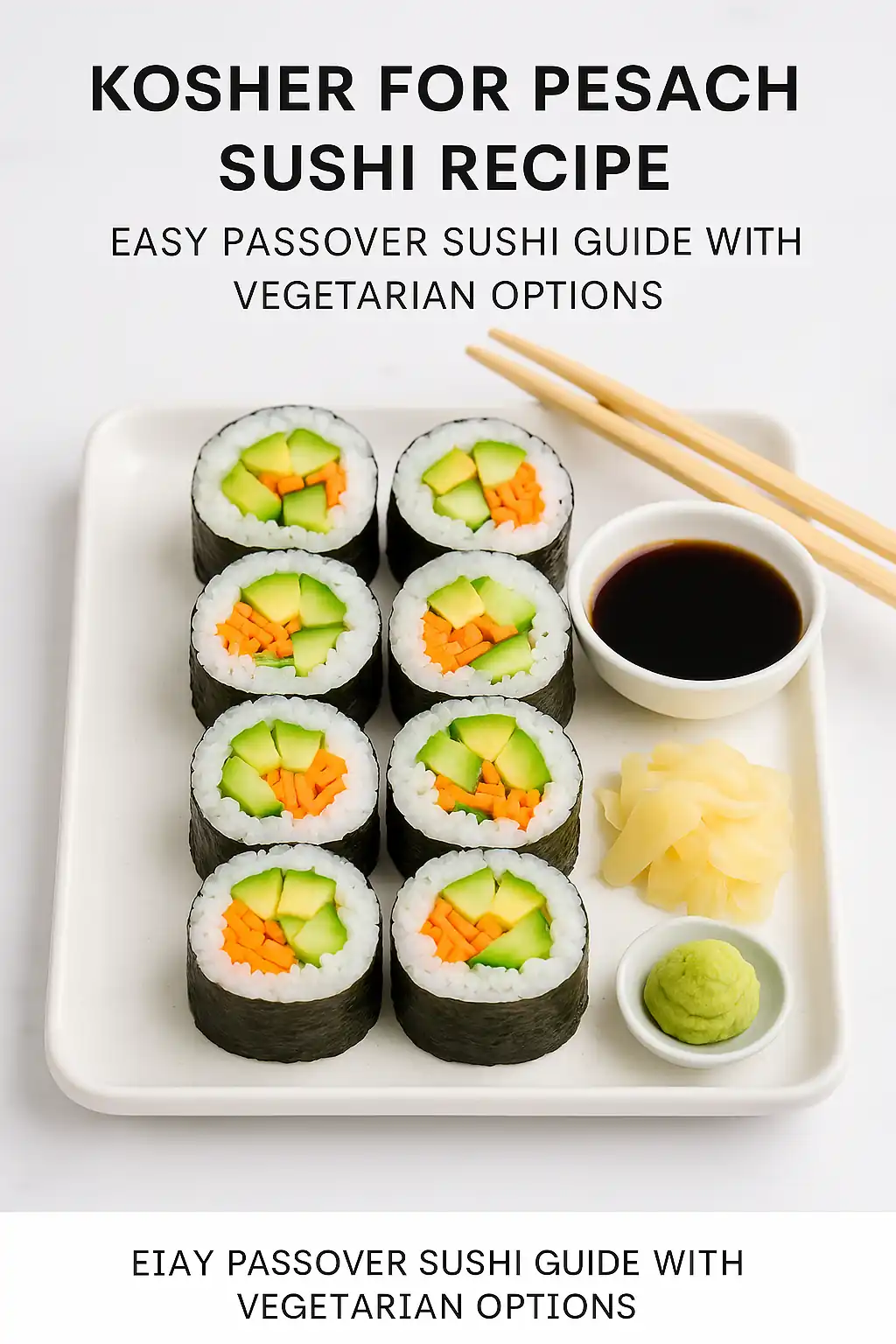Kosher for Pesach Sushi Recipe: A Delicious Homemade Passover Dish
Creating a kosher sushi recipe for Passover (Pesach) might seem like a culinary contradiction. Traditional sushi relies heavily on ingredients such as rice, soy sauce, and vinegar—many of which are problematic during the Jewish holiday of Pesach. But with a few substitutions and some creativity, it’s absolutely possible to prepare delicious Passover sushi that adheres to kosher guidelines and satisfies your sushi cravings.
This detailed guide explores everything you need to know about making kosher sushi during Pesach, including alternative grains, vegetarian filling ideas, homemade sauces, and even tools like a bamboo rolling mat. Whether you’re observing strict dietary laws or simply experimenting with new flavors, this recipe is designed for taste, authenticity, and tradition.
Understanding Kosher and Passover Guidelines
What Does Kosher Mean?
Kosher refers to foods prepared in accordance with Jewish dietary laws (Kashrut). These laws dictate how food should be sourced, processed, and consumed. For example, kosher fish must have fins and scales, and meat and dairy cannot be mixed in the same meal.
You can learn more about kosher dietary guidelines from My Jewish Learning, an educational resource on Jewish customs.
What Is Passover (Pesach)?
Passover, or Pesach in Hebrew, commemorates the Jewish people’s liberation from slavery in Egypt. During this week-long holiday, leavened grains (chametz) are prohibited. This includes wheat, barley, rye, oats, and spelt unless they’ve been prepared according to special guidelines. Many Jewish families also avoid kitniyot—legumes like rice, corn, and lentils—though this varies by tradition.
The Passover dietary laws are discussed extensively by Chabad.org, a trusted Jewish educational site.
Sushi Without Rice – Kosher Substitutes for Pesach
Why Regular Sushi Rice Is Not Kosher for Pesach
Sushi rice is usually short-grain white rice seasoned with rice vinegar, sugar, and salt. However, during Pesach, traditional rice is considered kitniyot and is avoided by Ashkenazi Jews. Additionally, rice vinegar may be made with fermented grains, rendering it chametz.
Using Quinoa as a Grain Substitute
Quinoa has become a popular Passover-approved alternative. Although technically a seed, quinoa is not considered a legume or grain in most Jewish traditions. It’s high in protein, gluten-free, and has a pleasant texture similar to sushi rice when cooked properly.
Find Passover quinoa preparation tips from OU Kosher, which discusses halachic opinions on quinoa.
Essential Ingredients for Kosher Passover Sushi
Substitute Ingredients for Sushi Recipe
Instead of traditional sushi rice and vinegar, your ingredient list should include:
-
Cooked quinoa or mashed cauliflower as a base
-
Salt and sugar for seasoning (ensure they are kosher for Pesach)
-
Matzo meal or whole matzah for added texture or binding
-
Homemade dressing made from lemon juice, vinegar alternatives, or fresh herbs
-
Nori sheets (certified kosher for Passover)
Sushi Fillings that Follow Passover Laws
Whether you’re making vegetarian or smoked salmon rolls, fillings must also be kosher and chametz-free:
-
Avocado
-
Cucumber
-
Carrot
-
Horseradish (fresh or mixed into a dip)
-
Smoked salmon (certified kosher)
-
Cauliflower rice
-
Passover-approved sauces like homemade mayonnaise or non-soy-based dip
You can find guidelines on Passover-approved products on Star-K Kosher Certification.
Equipment You’ll Need for Rolling Passover Sushi
Tools and Utensils for the Sushi Recipe
-
Bamboo mat or rolling mat for shaping the rolls
-
Sharp knife to cleanly slice your sushi
-
Bowl of cold water for wetting fingers and sealing nori
-
Wet cloth to cover rolls while prepping
-
Food processor if making cauliflower “rice”
Hygiene and Preparation Tips
Use separate utensils and bowls designated for Passover. Avoid cross-contamination by cleaning all surfaces and keeping chametz far away from the preparation area. More Passover kitchen prep tips can be found at Jewish Virtual Library.
Step-by-Step Kosher for Pesach Sushi Recipe
Prepare the Quinoa or Cauliflower Base
-
Rinse 1 cup of quinoa thoroughly and simmer with 2 cups of water and a pinch of salt.
-
Cook for 15-20 minutes until fluffy and let it cool.
-
For cauliflower: pulse florets in a food processor until they resemble rice. Steam lightly and strain.
Seasoning Without Chametz
Mix your base with a blend of lemon juice, sugar and salt, and a touch of olive oil to enhance the flavor. This mimics the slight tang usually provided by rice vinegar.
Lay Out and Fill the Nori Sheets
-
Place your nori (check for kosher-for-Pesach certification) on the bamboo mat.
-
Spread your quinoa or cauliflower mixture in a thin layer across the sheet.
-
Add your filling – avocado slices, carrot strips, smoked salmon, or cucumber.
-
Use a sharp knife dipped in water to cut the sushi.
Roll and Slice with Precision
Use gentle pressure to seal the roll. Cut the sushi into bite-sized pieces using a sharp knife. Clean your knife between cuts to ensure smooth slices.
More about sushi rolling techniques can be found on Just One Cookbook, a reputable resource for Japanese cooking methods.
Passover-Friendly Sauces and Dips
Horseradish Mayo
A simple combination of horseradish and mayonnaise (kosher for Pesach) creates a spicy dip. Perfect for adding bold flavor to vegetarian rolls.
Non-Soy Sauce Alternatives
Since soy sauce is made from fermented soybeans (a legume), it is not allowed during Passover. Consider a tamari-style dressing made from mushrooms and vinegar alternatives.
Check Kosher.com for Passover-safe condiment recipes and ingredient certifications.
Vegetarian Sushi Options for Pesach
Why Choose Vegetarian for Passover?
Vegetarian options are naturally free from many kosher complications and are easier to prepare without compromising flavor. They also cater to broader dietary needs.
Vegetarian Sushi Fillings
-
Shredded carrots
-
Mashed avocado
-
Cauliflower rice with herbs
-
Cucumber matchsticks
-
Fresh parsley and lemon zest
Try pairing with a simple herb-based dressing for added zest.
Matzah Sushi Variations
Using Matzah Instead of Nori
Some families avoid seaweed or nori during Passover. In such cases, you can use whole matzah as a wrapper. Simply soak matzah slightly in warm water until flexible, then fill and roll like sushi.
This adaptation gives a crunchy texture and incorporates a symbolic Pesach ingredient.
Serving Suggestions and Timing
Serving as an Appetizer
Kosher for Pesach sushi makes an elegant appetizer for your Seder meal or a light lunch during the week of Passover. Arrange sushi slices on a platter with parsley sprigs, lemon wedges, and horseradish mayo.
Ready in Under 20 Minutes
With practice and pre-prepped ingredients, your sushi rolls can be ready in just 20 minutes—ideal for quick family meals.
Avoiding Common Mistakes
Watch the Sticky Factor
Quinoa or cauliflower won’t be as sticky as sushi rice. Use pressure during rolling and allow the mixture to cool completely. Slight moisture helps seal the roll.
Overfilling the Roll
Too much filling can prevent the nori or matzah from sealing. Start with modest amounts and layer evenly.
Nutrition and Dietary Benefits
Healthy and Kosher
Passover sushi is a healthy choice—low in saturated fat and high in fiber and nutrients, especially when using whole vegetables and seeds like sesame seeds.
Grain-Free Options for Special Diets
Using cauliflower or quinoa makes this recipe gluten-free and suitable for those avoiding grains or legumes during Pesach.
Homemade Kits and Prep Tips
Sushi Rolling Kits
Many Jewish stores offer Passover-approved sushi kits that include mats, knives, and kosher-certified nori.
Explore options and guidelines from Aish.com, a Jewish learning site with lifestyle and cooking sections.
Conclusion – Embracing Tradition with a Twist
Creating kosher sushi for Pesach is not just about replacing ingredients—it’s about embracing the traditions of the holiday while enjoying creative, delicious meals. Whether you’re preparing a vegetarian roll or experimenting with matzah as a wrapper, this Passover sushi recipe offers flexibility, nutrition, and flavor.
Use this guide to serve a dish that’s not only kosher but also meaningful. Celebrate your heritage through food and bring something new to your Seder table.

